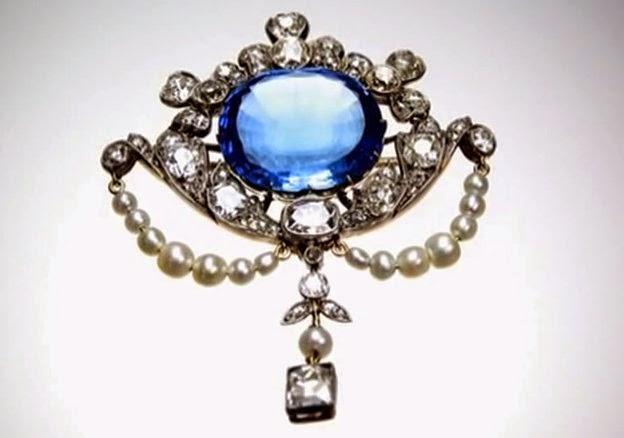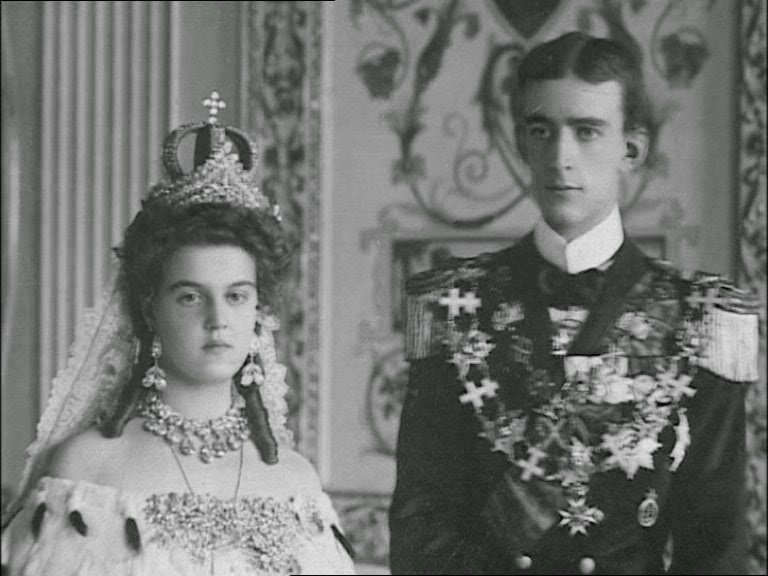The Connaught Sapphire Brooch
Mary wears a Connaught family brooch http://t.co/UjFhOs99Ql “@crownprincely New photo to celebrate 10th Anniversary pic.twitter.com/m6bmjEMN2h“
— Ella Kay (@courtjeweller) May 13, 2014

just as good a possibility to learn history. It shows how the families
have married through the generations. And it doesn’t only talk about
lineage, but it also relates to personal events in families.” I could not agree more!
Saturday Sparkler Special: Royal Wedding Tiaras
Country: SwedenCurrent Owner: King Carl XVI Gustaf of SwedenMaker: Marie-Étienne Nitot, ca. 1800Bridal Wearers: Princess Birgitta (1961), Princess Désirée (1964), Queen Silvia (1976), Crown Princess Victoria (2010)
Dating back to the imperial court of Napoléon Bonaparte, the Cameo Tiara is a part of a larger parure of cameo jewelry. Early wearers included Queen Hortense of Holland and Joséphine of Leuchtenberg. Appropriately for a tiara that has become associated with romance and weddings, the pearl and gold piece depicts scenes from the myth of Cupid and Psyche. The piece became a traditional bridal tiara in the middle of the twentieth century, when it was worn by Princesses Birgitta and Désirée (sisters of the present king) and Queen Silvia. The tradition stretched to a second generation of royal brides when Crown Princess Victoria wore it to marry Daniel Westling in 2010.
Country: Germany, Greece, Spain
Current Owner: Queen Sofia of Spain
Maker: Koch, ca. 1913
Bridal Wearers: Viktoria Luise of Prussia (1913), Queen Sofia (1962), Queen Letizia (2004)
Rather than belonging to a single nation’s royal family, the Prussian Tiara has passed through a line of royal women that stretches from imperial Germany to present-day Spain. The diamond and platinum tiara was worn by Princess Viktoria Luise of Prussia, daughter of the last kaiser, at her wedding in 1913. Her granddaughter, Princess Sophia of Greece and Denmark, wore the piece in Athens when she wed Juan Carlos of Spain in 1962. And the present Spanish queen, Letizia, borrowed the tiara from her new mother-in-law for her royal wedding in Madrid in 2004.
Country: Luxembourg, Liechtenstein
Current Owner: Grand Duke Henri of Luxembourg
Maker: Van Cleef and Arpels, ca. 1953
Bridal Wearers: Grand Duchess Joséphine-Charlotte (1953), Grand Duchess Maria Teresa (1981), Princess Marie Astrid (1982), Princess Margaretha (1982)
Two generations of Luxembourgish royal brides have worn this convertible necklace/tiara, which was made using diamonds given to Grand Duchess Joséphine-Charlotte as a wedding gift by the colonial government of the Belgian Congo. The piece also has a matching bracelet. It was worn by Joséphine-Charlotte at her religious wedding ceremony (though not in her wedding portraits); her two daughters, Marie Astrid and Margaretha, and her daughter-in-law, Grand Duchess Maria Teresa, also wore the tiara at their weddings. After Joséphine-Charlotte’s death, the tiara was nearly sold at auction; however, after the public protested, it was returned to the grand ducal vaults.
Country: United Kingdom
Current Owner: Queen Elizabeth II of the United Kingdom
Maker: E. Wolff and Co. for Garrard, ca. 1919
Bridal Wearers: Queen Elizabeth II (1947), Princess Anne (1973)
Unlike many royal families, the Brits don’t really have one dedicated
tiara in their arsenal meant for brides. The closest the family has to a
wedding tiara is this piece: the fringe tiara that first belonged to
Queen Mary. The present Queen wore the tiara to marry Prince Philip in 1947, although the tiara snapped shortly before the ceremony and had to be hastily repaired. Her only daughter, Princess Anne, also wore the tiara at her first wedding in 1973. Since then, however, British royal brides have opted for different wedding jewels.
 |
| Maria Pavlovna the Younger (source) |
Country: Russia
Current Owner: the Russian government
Maker: Jacob David Duval, ca. 1800
Bridal Wearers: numerous Romanov brides, including Elizabeth Feodorovna (1884), Elizabeth Mavrikievna (1884), Alexandra Feodorovna (1894), Elena Vladimirovna (1902), and Maria Pavlovna (1908)
The Russian imperial family decked its brides in numerous traditional wedding jewels, including this tiara, which featured a large pink diamond in the center, a nuptial crown, a necklace, earrings, and an incredibly large brooch used to clasp the bride’s ermine mantle. The jewels were scattered after the revolution. The government has retained the tiara, while the crown resides in the Hillwood Museum in Washington, D.C., the earrings and the buckle brooch are, I believe, in the nation’s Diamond Fund, and the necklace appears to have vanished.
Country: Denmark, Germany, Greece
Current Owner: Anne-Marie of Greece
Maker: Cartier, ca. 1905
Bridal Wearers: Anne-Marie of Greece (1964), Queen Margrethe II of Denmark (1967), Benedikte of Sayn-Wittgenstein-Berleburg (1968), Alexandra of Sayn-Wittgenstein-Berleburg (1998), Alexia of Greece and Denmark (1999), Nathalie of Sayn-Wittgenstein-Berleburg (2010)
Given to Princess Margaret of Connaught as a wedding present by the Khedive of Egypt, this Cartier tiara has become the official bridal diadem of her daughter’s family. All of Queen Ingrid’s daughters and granddaughters has worn the tiara so far at their weddings, and there are a number of additional female-line descendants who will also one day be eligible to wear the sparkler. The tiara now resides in the collection of Ingrid’s youngest daughter, Anne-Marie, the former Queen of Greece.
- « Previous Page
- 1
- …
- 218
- 219
- 220
- 221
- 222
- …
- 248
- Next Page »